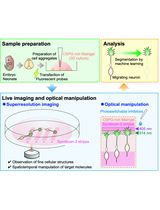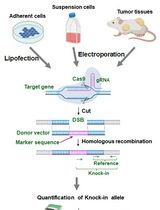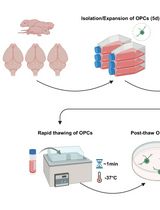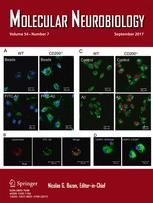- Submit a Protocol
- Receive Our Alerts
- Log in
- /
- Sign up
- My Bio Page
- Edit My Profile
- Change Password
- Log Out
- EN
- EN - English
- CN - 中文
- Protocols
- Articles and Issues
- For Authors
- About
- Become a Reviewer
- EN - English
- CN - 中文
- Home
- Protocols
- Articles and Issues
- For Authors
- About
- Become a Reviewer
Isolation and Maintenance of Murine Embryonic Striatal Neurons
Published: Vol 8, Iss 8, Apr 20, 2018 DOI: 10.21769/BioProtoc.2823 Views: 10600
Reviewed by: Oneil G. BhalalaTatiana Rosado RosenstockRyohei Iwata

Protocol Collections
Comprehensive collections of detailed, peer-reviewed protocols focusing on specific topics
Related protocols

Time-Lapse Super-Resolution Imaging and Optical Manipulation of Growth Cones in Elongating Axons and Migrating Neurons
Masato Sawada [...] Kazunobu Sawamoto
Mar 20, 2025 1884 Views

Assay for Site-Specific Homologous Recombination Activity in Adherent Cells, Suspension Cells, and Tumor Tissues
Yuki Yoshino [...] Natsuko Chiba
Apr 5, 2025 2186 Views

Cryopreservation of Bulk-Produced Primary Rat Oligodendrocyte Progenitor Cells
Hanki Kim [...] Jun Young Choi
Jun 20, 2025 1269 Views
Abstract
Primary cultures of murine striatal neurons are widely used to explore cellular mechanisms in neurobiology, including brain diseases. Here we describe a detailed and standardized protocol to dissect and culture embryonic murine striatal neurons GABA-positive/DARPP-32-positive for 12 days in vitro, when they show good neuronal cell connectivity and the presence of dendritic spines, which reflects the maturation of the network.
Keywords: Primary culturesBackground
Striatum is a critical component of the motor and reward systems and dysfunction of striatal neurons can lead to a variety of neuronal disorders, from obsessive-compulsive-like behaviors (Welch et al., 2007) to neurodegeneration, as observed in Huntington’s disease (Reiner et al., 1988). Therefore, a well-stablished striatal culture may be a great value as a model for studying these and other conditions. The major neuronal subtype in adult striatum is medium spiny projection neurons (MSNs), which constitutes approximately 95% of all striatal neurons and use the inhibitory transmitter gamma-aminobutyric acid (GABA). They are characterized by medium-sized cell bodies, complex dendritic arbors and a high density of dendritic spines that receive both glutamatergic and dopaminergic inputs. The remaining 5% of neurons are composed by GABAergic aspiny interneurons (Graveland and DiFiglia, 1985; Matamales et al., 2009). The following protocol describes the preparation of primary cultures of mouse embryonic striatal neurons with a low percentage of astrocytes, which proliferation is prevented by the mitosis inhibitor 5-fluoro-2’-deoxyuridine (5-FdU). After 12 days in vitro (DIV) the striatal neurons obtained by the described protocol are expected to be immunolabeled for microtubule-associated protein 2 (MAP2) or NeuN, GABA and a large percentage for dopamine- and cAMP-regulated phosphoprotein (DARPP-32).
Materials and Reagents
- Coverslips 18 mm diameter round, #1.5 (0.17 mm) thickness (Thermo Fisher Scientific, Menzel, catalog number: 11817742 )
- Sterile non-tissue culture treated Petri dishes of 35, 60 and 100 mm (VWR, catalog numbers: 734-1707 , 734-1708 , 734-1709 )
- 5, 10 ml serological sterile pipettes (Labbox, catalog numbers: MPIP-U05-200 , MPIP-U10-200 )
- Sterile 0.2-10 μl, 10-200 μl and 100-1,000 μl micropipette tips (Frilabo, catalog numbers: 170558 , 171017 , 171024 )
- 15 and 50 ml sterile conical centrifuge tubes (Corning, catalog numbers: 430791 , 430829 )
- Sterile 1.5 ml microcentrifuge tubes (BIOplastics, catalog number: B74085 )
- Sterile syringes, 20 ml (Terumo, catalog number: SS+20L1 )
- Sterile 230 mm glass Pasteur pipettes (Labbox, catalog number: PIPN-230-250 )
- Sterile 0.2 μm acetate cellulose filters (GE Healthcare, Whatman, catalog number: 28415732 )
- Vacuum 0.2 μm filter bottle system, 500 ml (Corning, catalog number: 430769 )
- Cell strainers, 40 μm (Corning, Falcon®, catalog number: 352340 )
- Multi-wells tissue culture treated, flat bottom, polystyrene (Corning, catalog numbers: 3596 , 3548 , 3524 , 3512 , 3506 )
- Pregnant female mice (Mus musculus) with 16 days of gestation
Note: In this protocol, mice from FVB/NJ inbred strain (THE JACKSON LABORATORY) were used. - Hydrochloric acid (HCl), 37% (Sigma-Aldrich, catalog number: 435570 )
- Ethanol absolute 99.8% (Fisher Scientific, catalog number: 10342652 )
- Isoflurane Iso-Vet 1,000 mg/g Inhalation Vapour (Chanelle UK)
- Fetal bovine serum (FBS) (Thermo Fisher Scientific, GibcoTM, catalog number: 10270106 )
- Trypan blue solution, 0.4% (Sigma-Aldrich, catalog number: T8154 )
- 5-FdU (Sigma-Aldrich, catalog number: F0503 )
- Anti-MAP2 (1:500; Santa Cruz Biotechnology, catalog number: sc-32791 )
- Anti-GABA (1:500; Sigma-Aldrich, catalog number: A2052 )
- Anti-DARPP32 (1:100; Abcam, catalog number: ab40801 )
- Goat anti-rabbit IgG secondary antibody, Alexa Fluor 594 (1:200; Thermo Fisher Scientific, Invitrogen, catalog number: R37117 )
- Donkey anti-mouse IgG secondary antibody, Alexa Fluor 488 (1:200; Thermo Fisher Scientific, Invitrogen, catalog number: R37114 )
- Boric acid (H3BO3) (Sigma-Aldrich, catalog number: B6768 )
- Poly-D-lysine hydrobromide (Sigma-Aldrich, catalog number: P1149 )
- Potassium chloride (KCl) (Labbox, catalog number: POCL-00P-1K0 )
- Potassium phosphate monobasic (KH2PO4) (Sigma-Aldrich, catalog number: P5655 )
- Sodium chloride (NaCl) (Merck, catalog number: 106404 )
- Sodium bicarbonate (NaHCO3) (Sigma-Aldrich, catalog number: S5761 )
- Sodium phosphate monobasic (NaH2PO4) (Sigma-Aldrich, catalog number: S3139 )
- D-(+)-Glucose (Sigma-Aldrich, catalog number: G8270 )
- Sodium pyruvate (100 mM) (Thermo Fisher Scientific, GibcoTM, catalog number: 11360070 )
- HEPES (Sigma-Aldrich, catalog number: H3375 )
- Phenol red (Sigma-Aldrich, catalog number: P3532 )
- Deoxyribonuclease I (DNase I) (Sigma-Aldrich, catalog number: D5025 )
- Bovine serum albumin (BSA) fatty acid free (Sigma-Aldrich, catalog number: A6003 )
- Trypsin, Type IV-S, from porcine pancreas (Sigma-Aldrich, catalog number: T0303 )
- Trypsin inhibitor, type II-S: Soybean (Sigma-Aldrich, catalog number: T9128 )
- L-Glutamine (200 mM) (Thermo Fisher Scientific, GibcoTM, catalog number: 25030081 )
- Gentamicin (50 mg/ml) (Thermo Fisher Scientific, catalog number: 15750060 )
- Neurobasal medium (Thermo Fisher Scientific, GibcoTM, catalog number: 21103049 )
- B-27 supplement (50x), serum free (Thermo Fisher Scientific, GibcoTM, catalog number: 17504044 )
- Poly-D-lysine for coating (0.1 mg/ml) (see Recipes)
- Hanks’ balanced salt solution (HBSS) (see Recipes)
- DNase I solution (5 mg/ml) (see Recipes)
- BSA solution (3 mg/ml) (see Recipes)
- Trypsin solution (0.5 mg/ml) (see Recipes)
- Trypsin inhibitor solution (1 mg/ml) (see Recipes)
- Washing solution (see Recipes)
- Inactivated FBS (see Recipes)
- Supplemented Neurobasal medium (see Recipes)
Equipment
- 11.5 cm fine straight scissor (Fine Science Tools, Dumont, catalog number: 14060-11 )
- 8.5 cm mini-dissecting scissor, straight with sharp tip (World Precision Instruments, catalog number: 503669 )
- Medium forceps (Fine Science Tools, model: Dumont #7, catalog number: 11274-20 )
- Forceps with straight and angled fine tip (Fine Science Tools, models: Dumont #5 and Dumont #5/45 )
- Automatic pipettor and micropipettes
- Glass Schott laboratory bottle with cap, 500 ml (DWK Life Sciences, Duran, catalog number: 21 801 44 5 )
- Water bath with electronic temperature regulation
- Ultrasonic cleaning bath (just for coverslips washing)
- Zeiss Stemi magnification glass (or equivalent)
- Phase contrast inverted microscope equipped with 10x and 20x objectives
- Zeiss LSM 710 point-scanning confocal microscope (ZEISS, model: LSM 710 or equivalent)
- Hemocytometer (Sigma-Aldrich, catalog number: Z359629 )
- Water jacketed CO2 incubator
- Vertical laminar flow chamber
- Isoflurane vaporizer apparatus (E-Z Anesthesia, model: EZ-SA800 , or equivalent)
Software
- Fiji software (ImageJ, National Institute of Health, USA)
Procedure
Note: Except for the coverslips washing (described in the following Procedure A, before poly-D-lysine coating) and brain dissection, all the procedures must be done in a sterile environment using a flow chamber.
- Coverslips washing (timing ~20 h; before poly-D-lysine coating)
- Heat coverslips in a loosely covered glass bottle embedded in 1 M HCl at 50-60 °C for 4-16 h with occasional swirling. Use few coverslips at a time to prevent them from sticking each other. Acid washing protocol is recommended by the manufacturers for both enhancing the cleanliness of the coverslip and increasing cellular attachment.
- Cool at room temperature and carefully decant the HCl solution into an appropriate container. Rinse thoroughly with ddH2O and fill the glass bottle with ddH2O. Sonicate in a water bath for 30 min. Repeat the sonication step twice.
- Replace the ddH2O for a solution of 50% ethanol (v/v) and sonicate in a water bath for 30 min. Repeat the sonication step twice with an increasing concentration of ethanol: (i) 70% ethanol (v/v), (ii) 95% ethanol (v/v). Coverslips can be stored submerged in ethanol absolute ≥ 99.8% (v/v) for up to 6 months.
- Before use, sterilize the coverslips exposing them to UV light for ~15 min or by dry-heat sterilization.
- Heat coverslips in a loosely covered glass bottle embedded in 1 M HCl at 50-60 °C for 4-16 h with occasional swirling. Use few coverslips at a time to prevent them from sticking each other. Acid washing protocol is recommended by the manufacturers for both enhancing the cleanliness of the coverslip and increasing cellular attachment.
- Poly-D-lysine coating (timing ~2.5 h; 1 day before culture)
- Add the previously prepared 0.1 mg/ml poly-D-lysine solution to the plates/coverslips desired for the culture until it covers the bottom. Incubate the plates/coverslips for at least 2 h, preferably overnight, at 37 °C in a humidified incubator.
- Aspirate the poly-D-lysine with a Pasteur pipette and rinse twice with sterile water. Remove the water and allow the well to dry in the laminar flow chamber.
- Store at 4 °C for up to 1 month.
- Add the previously prepared 0.1 mg/ml poly-D-lysine solution to the plates/coverslips desired for the culture until it covers the bottom. Incubate the plates/coverslips for at least 2 h, preferably overnight, at 37 °C in a humidified incubator.
- Brain and striatum dissection (timing 1 h 30 min)
- Soak all the dissecting tools in 70% ethanol (v/v) before starting the dissection. Also, during the dissection routinely dip the dissecting tools in 70% ethanol (v/v) to reduce contaminations. Dry thoroughly before using.
- Anesthetize the pregnant female mice at gestational day 16 with 5% isoflurane (v/v) and sacrifice it by cervical dislocation (or choose an appropriate anesthesia according to the recommendations of the Institutional Animal Care and Use Committee ruling in the respective country of research). Place the mouse on its belly up and thoroughly rinse abdomen with 70% ethanol (v/v). Collect the embryos by cesarean-section by grasping the uterus with sterile forceps and cutting the connection with the mesometrium. Put the embryos in an HBSS-filled 100 mm Petri dish.
- Remove each embryo from the embryonic sac and rapidly decapitate it. Transfer the embryos’ heads to an HBSS-filled 60 mm Petri dish and keep it on ice.
- Using a pair of forceps, hold the head of the embryo and insert the tip of a straight Dumont #5 forceps between eyes to keep the head fixed above the surface. With the mini dissecting scissor pointed up, begin to cut the skin and skull from the end of the spinal cord (which is visible after decapitation) through the longitudinal fissure until the end of the head cavity. Support the head in the Petri dish and gently squeeze the brain out from the brain cavity in a frontal-occipital direction using an angled Dumont #5/45 forceps. Transfer one brain at a time to a new HBSS-filled 60 mm Petri dish (see Video 1).Video 1. Exemplification of how to remove the mouse brain from the skull
- Turn on the magnifying glass and adjust it for approximately 25x magnification. With the brain faced upward, start the dissection by making a sagittal cut approximately 1 mm parallel to the midline using the angled Dumont #5/45 forceps. Use this cut to facilitate the removal of the meninges from the cortex (see Video 2/Figures 1A-1D). To stabilize the brain during dissection, use a straight Dumont #5 forceps to gently hold the brain between the forebrain and the cerebellum.Video 2. Isolation of striatum from embryonic E16 mouse brain
- Open the slit with the help of the same angled forceps to unfold the anterior cortex overlaying the lateral ventricle and the ganglionic eminences. The striatum, presenting an irrigated oval structure, is located in the lateral eminence. Use the tips of the angled forceps to cut out the striatum pinching around, as shown in Video 2/Figures 1E-1F. Transfer it to a sterile HBSS-filled 35 mm Petri dish.
- Repeat the procedure on the other lobe and for each brain until all striata are collected. The remaining tissue can be harnessed to isolate the hippocampus, the cortex or other brain areas of interest.

Figure 1. Steps for striata dissection from embryonic E16 mouse brains. A and B. Dorsal positioned embryos brains (C) are cut parallel to the central plane of the sagittal suture. Hold the cerebellum (Ce) with a straight Dumont #5 forceps to keep the brain stable during dissection. D. Using the open slit pull out the meninges (asterisk, *), which cover the whole forebrain (Fb). Afterward, use an angled Dumont #5/45 forceps (E) to unfold the anterior cortex (Cx) and (F) remove the striatum (St), next to the lateral ventricle, with a typical striated appearance that is not always visible at 25x magnification. Ob, olfactory bulbs; Bs, brainstem.
- Soak all the dissecting tools in 70% ethanol (v/v) before starting the dissection. Also, during the dissection routinely dip the dissecting tools in 70% ethanol (v/v) to reduce contaminations. Dry thoroughly before using.
- Dissociation and plating of striatal cells (timing 30 min)
- Transfer the striata into sterile HBSS medium (7 ml) to a 15 ml-Falcon.
- Add 3 ml of trypsin solution and mix by gently inverting the tube. Incubate for 2-3 min in a 37 °C water bath gently mixing from time to time. Note that depending on the amount of tissue and the trypsin activity the trypsinization time may change. The current protocol is optimized to 3 ml of trypsin solution for about 6 embryos; an increased number of embryos may require an adjustment of the total volume of the solution, maintaining the trypsin ratio.
- Inactivate the trypsin by adding 5 ml of trypsin inhibitor solution. Note that if the volume added in the previous step is changed, the volume of trypsin inhibitor solution should be added accordingly. Mix by gently inverting the tube and wait until tissue settle. Aspirate the medium.
- Wash the cells by adding 5 ml of washing solution (trypsin inhibitor in BSA solution, 1:5) and mix by inverting the tube. Allow tissue to settle and aspirate as much volume as possible without disturbing the pellet.
- Add 2-3 ml of supplemented Neurobasal medium with 0.5% FBS and gently homogenize with P1000 pipette until the solution is homogeneous. Note that if trypsinization step is adequate, an aggressive trituration is not required, as too much physical stress on cells during mechanical homogenization will reduce cell viability.
- Prepare a 1.5 ml Eppendorf with 20 μl of cell suspension, 20 μl of Neurobasal medium and 20 μl of trypan blue solution, creating a 3-fold dilution factor. Use an inverted phase contrast microscope to count the number of viable cells in a hemocytometer and plate at a density of 130 x 103 cells/cm2. For low density cultures in coverslips plate 92 x 103 cells/cm2. Neurons are maintained at 37 °C in a humidified incubator with 5% CO2/95% air, for 12 days.
- At DIV3 remove one-third of culture medium and add an equal part of volume of fresh supplemented Neurobasal medium without FBS and containing 15 μM 5-FdU (final concentration of 5 μM) to reduce dividing non-neuronal cells in primary culture (Hui et al., 2016). Under these conditions, we observed approximately 15% of Glial fibrillary acidic protein (GFAP)-positive cells (data not shown). At DIV7 change the medium again by replacing half of the culture medium to fresh supplemented Neurobasal medium devoid of FBS and 5-FdU.
- Characterize your primary striatal culture in terms of percentage of neurons (MAP2 or NeuN-positive), glial cells (GFAP or S100 beta-positive), GABAergic cells (GAD65 or GABA-positive), MSNs (DARPP-32-positive and GAD65 or GABA-positive) and GABAergic interneurons (GAD65-positive and DARPP-32-negative). Figure 2 shows a representative image of a primary striatal neuronal culture with approximately 82% of GABA-positive plus DARPP-32-positive striatal neurons.

Figure 2. Characterization of mouse primary striatal culture. DIV12 cultured striatal neurons were stained with anti-MAP2 (1:500; Santa Cruz Biotechnology) antibody conjugated with secondary Alexa Fluor 594 (1:200; Ex: 590 nm, Em: 617 nm) together with (A) anti-GABA (1:500; Sigma-Aldrich) or (B) anti-DARPP32 (1:100; Abcam) antibodies conjugated with secondary Alexa Fluor 488 (1:200; Ex: 495 nm, Em: 519 nm). A secondary antibody-only control staining was performed, which showed no signal. Z-stack confocal images obtained with a 20x objective, NA=1.4 on an inverted confocal microscope. Scale bars = 50 μm.
- Transfer the striata into sterile HBSS medium (7 ml) to a 15 ml-Falcon.
Data analysis
For striatal cultures characterization, 6 to 8 images per individual experiment were randomly taken with confocal microscope for each antibody labeled. GABA- and DARPP-32-positive cells were counted using Fiji software (ImageJ, National Institute of Health, USA) with Cell Counter plugin, and the percentage were calculated in relative to MAP2-positive cells.
Recipes
- Poly-D-lysine for coating (0.1 mg/ml)
- Prepare a solution of 166 mM boric acid in type I (ultrapure, > 17.4 MΩ resistance) water and adjust the pH to 8.2
- Just before use, dilute the poly-D-lysine in the previous prepared boric acid solution and filter the solution in a laminar flow with a filtration unit
- Prepare a solution of 166 mM boric acid in type I (ultrapure, > 17.4 MΩ resistance) water and adjust the pH to 8.2
- Hanks’ balanced salt solution (HBSS)
5.36 mM KCl
0.44 mM KH2PO4
137 mM NaCl
4.16 mM NaHCO3
0.34 mM NaH2PO4
5 mM glucose
5.36 mM sodium pyruvate
5.36 mM HEPES
0.001% phenol red
Adjust the pH to 7.2 and filter the solution in a laminar flow with a vacuum filter system unit. Store at 4 °C, for no more than 1 month - DNase I solution (5 mg/ml)
5 mg DNase I in 1 ml of 0.15 M NaCl
Store at -20 °C in small aliquots for 1 week
Note: Higher concentrations of this solution may lose enzymatic activity. - BSA solution (3 mg/ml)
150 mg BSA in 50 ml HBSS
In a laminar flow, filter the solution with a 0.20 μm acetate cellulose filter
Prepare just before use - Trypsin solution (0.5 mg/ml)
2.5 mg trypsin in 5 ml BSA solution
Add 50 μl of 5 mg/ml DNase I solution
In a laminar flow filter the solution using a 0.20 μm acetate cellulose filter
Prepare just before use - Trypsin inhibitor solution (1 mg/ml)
10 mg of trypsin inhibitor in 10 ml BSA solution
In a laminar flow filter the solution with a 0.20 μm acetate cellulose filter
Prepare just before use - Washing solution
Dilute the sterile trypsin inhibitor solution in BSA solution in a proportion of 1:5, to make a final volume of 10 ml
Prepare just before use - Inactivated FBS
To inactivate the FBS stock solution, warm it in a water bath at 56 °C for 30 min
Aliquot the FBS and store at -20 °C until shelf life expiration date - Supplemented Neurobasal medium
- Supplement the 500 ml bottle of Neurobasal medium with 1.25 ml of L-glutamine and 0.5 ml of gentamicin (to obtain a final concentration of 0.5 mM and 50 μg/ml, respectively)
- Make aliquots of 49 ml Neurobasal medium in sterile centrifuge tubes
- Add 1 ml of B-27 supplement (50x) to achieve a final volume of 50 ml. Once supplemented, the Neurobasal medium is stable for up to 1 week if stored at 4 °C protected from light
- On the day of culture, and only for the plating medium, add 0.25 ml of inactivated FBS in 50 ml supplemented Neurobasal medium (for a final concentration of 0.5%)
- Supplement the 500 ml bottle of Neurobasal medium with 1.25 ml of L-glutamine and 0.5 ml of gentamicin (to obtain a final concentration of 0.5 mM and 50 μg/ml, respectively)
Acknowledgments
We would like to thank Carina Maranga (CNC, University of Coimbra, Coimbra, Portugal) for assisting in filming brain dissection. This work was supported by European community FEDER fund through the ‘Programa Operacional Factores de Competitividade’ – COMPETE 2020; and national funds by ‘Fundação para a Ciência e a Tecnologia’ (FCT), Portugal [project ref. POCI-01-0145-FEDER-007440]. FVB/NJ mice used in these primary cultures were supported by a project financed by Teva Pharmaceutical Industries Ltd. The authors declare that they have no financial or competing conflict of interests.
References
- Graveland, G. A. and DiFiglia, M. (1985). The frequency and distribution of medium-sized neurons with indented nuclei in the primate and rodent neostriatum. Brain Res 327(1-2): 307-311.
- Hui, C. W., Zhang, Y. and Herrup, K. (2016). Non-neuronal cells are required to mediate the effects of neuroinflammation: results from a neuron-enriched culture system. PLoS One 11(1): e0147134.
- Matamales, M., Bertran-Gonzalez, J., Salomon, L., Degos, B., Deniau, J. M., Valjent, E., Herve, D. and Girault, J. A. (2009). Striatal medium-sized spiny neurons: identification by nuclear staining and study of neuronal subpopulations in BAC transgenic mice. PLoS One 4(3): e4770.
- Reiner, A., Albin, R. L., Anderson, K. D., D'Amato, C. J., Penney, J. B. and Young, A. B. (1988). Differential loss of striatal projection neurons in Huntington disease. Proc Natl Acad Sci U S A 85(15): 5733-5737.
- Welch, J. M., Lu, J., Rodriguiz, R. M., Trotta, N. C., Peca, J., Ding, J. D., Feliciano, C., Chen, M., Adams, J. P., Luo, J., Dudek, S. M., Weinberg, R. J., Calakos, N., Wetsel, W. C. and Feng, G. (2007). Cortico-striatal synaptic defects and OCD-like behaviours in Sapap3-mutant mice. Nature 448(7156): 894-900.
Article Information
Copyright
© 2018 The Authors; exclusive licensee Bio-protocol LLC.
How to cite
Naia, L. and Rego, A. C. (2018). Isolation and Maintenance of Murine Embryonic Striatal Neurons. Bio-protocol 8(8): e2823. DOI: 10.21769/BioProtoc.2823.
Category
Neuroscience > Cellular mechanisms > Cell isolation and culture
Cell Biology > Cell isolation and culture
Do you have any questions about this protocol?
Post your question to gather feedback from the community. We will also invite the authors of this article to respond.
Tips for asking effective questions
+ Description
Write a detailed description. Include all information that will help others answer your question including experimental processes, conditions, and relevant images.
Share
Bluesky
X
Copy link









